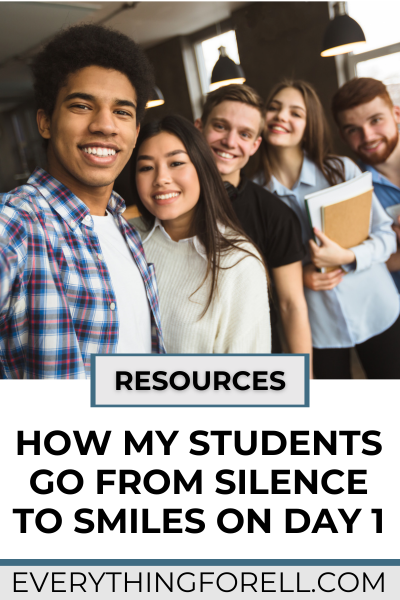It’s the first day of school, and your newcomer ESL students meet you at the door, often with a nervous smile and a schedule in hand because they want you to double-check and confirm that they are in the right place. The bell finally rings, and you can feel the anxious energy in your classroom. You close the door, smile, and say hello to a bunch of blank stares. An effective ESL icebreaker can change the tone.
If you’ve ever taught newcomer ESL students, you know this moment. You’re excited to welcome your new students, but they’re often scared and silent. You want to make them feel safe and welcomed, but you also don’t want to overwhelm them. You need to dance between expecting them to be students while respecting that they are new English language learners. So, how do we do that?
Let me share with you the ESL icebreaker I have used in my classroom for over 10 years. With visuals, movement, speaking, and writing stems, this is my go-to activity on the first day of school.
ESL Icebreakers Need Pictures, Choice, and Movement
When language is limited, the traditional ice-breaker activities not only fall flat, but often intimidate students into a silent period that lasts longer than you want.
So instead of asking students to share two truths and a lie, I have them choose “this” or “that,” which are illustrated on a Google slide with visuals and basic English. This is a cat. That is a dog. Which one do you like?
Students look at the board, see the cat and dog images, and then move to the side they prefer: left for the cat and right for the dog. I find that even for students with zero English, I can translate with Google, “What do you like?” and then point to the two options. Students then make their choice.
This low-risk interaction creates instant connections between students regardless of native language. The silent nerves begin to fall away to smiles, and that should be every teacher’s goal on the first week back to school.
Intentional ESL Ice-Breakers Pay Off
Most importantly, when students are invited to participate in class without needing to produce in an unknown language, it gives them the power to express who they are as unique individuals, not just what they know as English learners. A lesson like this pays off for a couple of reasons. First, you set the tone that students can and will be participating in class. “No sé” is no longer an excuse. Second, you validate the reality that learning another language is difficult, but it is a challenge you and your student will tackle together with respect and support.
What About Mixed-Level ESL Classes?
Many ESL teachers work with a range of language levels in one room. Some students may not know a single word in English. Some students may be able to speak in complete sentences. That’s why this icebeaker is designed with built-in differentiation.
For beginners:
- Use just the images
- Model gestures and pointing
- Encourage simple, single-word production like “cat” or “dog.”
For higher-level students:
- Use the speaking stems: “I like ___.”
- Encourage these students to explain why. This is a great way to see how they analyze and what sort of vocabulary they have in their mind.
- Have them write one thing they shared about themselves.
It’s the same set of slides, but every student can participate in a way that fits their language level.
From ESL Icebreaker to Pre-Assessment
The best part? This icebreaker isn’t just for the students; it’s for me. As students choose their “this” or “that,” I can understand:
- who my natural leader is when they explain directions for pre-production students
- who needs more time to warm up, but is willing to take language risks after seeing or hearing it modeled a few times
- who is not ready to produce and will need time to emerge
I will take my roster and mark 1, 2, or 3 next to each student so that the following day I can pair up my scared students with my natural talkers, and create differentiated levels that are ready to support English language learning.
What’s One Tip That Helps You Break the Ice?
I’d been doing this for a while, but I always want to see what other ESL teachers do, and I would love to hear your go-to activity. How do you help your newcomer ESL students feel brave enough to participate on the first day of school?
Drop your answer in the comments!
👉 Grab my “This or That” Beginner ESL Icebreaker HERE!
👉 If you need more ESL lessons, check out my store.














